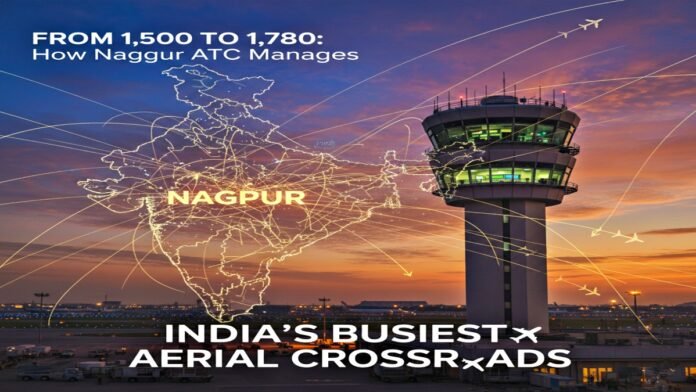
Key Points:
- Nagpur Air Traffic Control handles approximately 1,780 aircraft crossings daily in 2025, up from over 1,500 last year, with more than 100 aircraft requiring complex re-crossing maneuvers
- Over 70 critical “hotspots” exist in Nagpur’s airspace where aircraft intersect at altitudes exceeding 40,000 feet, requiring split-second decisions to prevent mid-air collisions
- Nagpur ATC’s operational radius covers approximately 3 lakh kilometers (300,000 km), providing air traffic services for Bhopal, Indore, Jabalpur, Gondia, Raipur, and multiple satellite airports
- ATC personnel strength increased from 137 to 160 controllers, with approximately 50 trained specifically for hotspot management; an additional 40 trained personnel still needed
- Nagpur’s airspace divided into North and South sectors, with a third sector being created to handle flights below 32,000 feet altitude
- Modern safety systems include conflict alerts and Traffic Collision Avoidance Systems (TCAS) that provide early warnings to pilots and controllers
- Nagpur Airport began 24×7 operations from April 1, 2025, transforming it into a high-traffic aviation hub with expanded flight schedules
- Union government planning ISHAN project (Indian Single Sky Harmonised Air Traffic) to consolidate India’s four Flight Information Regions into one unified system controlled from Nagpur
Nagpur: Nagpur’s Dr. Babasaheb Ambedkar International Airport has emerged as one of India’s most critical air traffic control centers, managing an extraordinary volume of daily flights while navigating one of the country’s most complex airspace environments. The centrally located airport’s strategic importance has grown significantly, with air traffic controllers facing the mounting challenge of ensuring safe passage for nearly 1,800 aircraft daily through a maze of aerial crossroads.
Dramatic Increase in Daily Flight Operations
According to a comprehensive report published by the Times of India in October 2025, Nagpur ATC currently manages between 1,680 and 1,780 aircraft flying over its airspace daily. This represents a substantial increase from last year’s figure of over 1,500 aircraft, reflecting the rapid growth in India’s aviation sector. The numbers have seen a gradual but consistent increase due to rising aviation activities nationwide, making Nagpur’s ATC the only one of its kind in the country, given its unique operational challenges.
70+ Critical Hotspots Demand Constant Vigilance
There are currently over 70 “hotspots” in the skies above Nagpur that keep air traffic controllers perpetually on high alert. These hotspots are critical crossing points where aircraft, even at altitudes exceeding 40,000 feet, intersect each other’s paths at the same level. Each aircraft must be maintained at a safe distance from others to ensure passenger safety, a task made exponentially more complex by the fact that modern commercial aircraft routinely travel at speeds exceeding 1,000 kilometers per hour.
Hotspots Have Doubled in a Decade
Sources within the aviation sector reveal that the increase in global flight activity has doubled the number of hotspots over Nagpur’s skies to 65-70 in the last decade alone. To put this in perspective, if compared to a highway, these are points where vehicles cross each other at extremely high speeds, and traffic must be constantly managed to prevent any mishap. The critical difference is that aircraft operate in three-dimensional space at speeds measured in Machs, covering thousands of kilometers in minutes, leaving virtually no margin for error.
Split-Second Decisions at Supersonic Speeds
The complexity of managing re-crossings where one aircraft approaches from one direction while another comes from a different trajectory requires extraordinary skill and composure from ATC personnel. Controllers must make decisions in moments, matching the speed of the flying machines they’re directing. When danger is suspected, one plane must be moved upwards, downwards, or sideways to make way for another, but this decision-making process must account for multiple factors simultaneously. There may be a third plane flying in the direction where one of the aircraft is being moved, leaving absolutely no room for wrong decisions, according to aviation experts.
Expansive Control Radius Covering Central India
Nagpur ATC’s operational radius spans approximately 3 lakh kilometers (300,000 kilometers), making it one of the largest air traffic control zones in India. The facility provides comprehensive landing and takeoff services for major airports, including Bhopal, Indore, Jabalpur, Gondia, and Raipur, along with several smaller airports and satellite facilities. Nagpur’s geographical position at the heart of India makes it inherently one of the busiest air traffic control centers, with aircraft from all directions converging over its airspace.
Manpower Expansion to Meet Growing Demands
Recognizing the increasing workload and critical nature of operations, Nagpur ATC has significantly expanded its personnel strength from 137 to 160 air traffic controllers. Among this enhanced team, approximately 50 controllers are specifically trained to work in hotspot situations, the most demanding and high-pressure scenarios in air traffic management. However, aviation authorities acknowledge that an additional 40 trained personnel are urgently needed to adequately manage the growing air traffic volume.
Specialized Training for Unique Challenges
The existing controllers in the 160-strong team are undergoing continuous training and are expected to eventually handle the complex air traffic patterns over Nagpur skies. Since each ATC tower has its own unique operational characteristics and challenges, controllers need to be specifically trained for managing traffic over Nagpur’s airspace. The headquarters has taken cognizance of this critical manpower requirement, and staffing numbers have been progressively increased to meet operational demands.
Airspace Sectorization for Efficient Management
To optimize control operations and improve safety margins, Nagpur’s airspace has been strategically divided into North and South sectors, each managed by a dedicated team of controllers. In a significant development, a third sector specifically designed to handle flights at altitudes below 32,000 feet is currently being created. Trials for this new sector are already underway, and once operational, it will further enhance the efficiency of air traffic management by segregating high-altitude and medium-altitude traffic.
Advanced Safety Technology Systems
Modern air traffic control systems deployed at Nagpur include sophisticated safety mechanisms such as conflict alerts and Traffic Collision Avoidance Systems (TCAS) for pilots. These systems provide early warning alerts before potential danger is detected, giving both controllers and pilots precious extra seconds to take corrective action. The conflict alert system automatically warns controllers when two aircraft are projected to violate minimum separation standards, while TCAS provides pilots with independent collision avoidance guidance.
Reduction in Lateral Separation Standards
Contributing to the rising complexity of operations, aviation authorities have reduced the lateral distance requirement between aircraft to just 5 nautical miles in certain situations. While this reduction increases airspace capacity and allows more aircraft to operate simultaneously, it also demands even greater precision and vigilance from air traffic controllers. This factor, combined with increasing flight volumes, has significantly elevated the workload and stress levels for Nagpur’s ATC personnel.
Perfect Safety Record Despite Challenges
Despite managing one of the most congested and complex airspaces in India, Nagpur ATC has maintained an impeccable safety record with no incidents affecting the mid-air safety of passengers, according to sources familiar with operations. This remarkable achievement is a testament to the skill, training, and dedication of the air traffic controllers who remain ever vigilant and make quick decisions considering multiple variables simultaneously.
24×7 Operations Since April 2025
In a major milestone that has further amplified operational demands, Dr. Babasaheb Ambedkar International Airport in Nagpur began round-the-clock operations starting April 1, 2025. This decision was finalized following approvals granted during the slot coordination meeting in Delhi held from February 18-21, 2025. The summer schedule spanning from March 30 to October 25, 2025, was formalized during these discussions, introducing afternoon departures and arrivals alongside flights within the traditional 10 AM to 6 PM window.
Strategic Hub for India’s Aviation Growth
Aviation analysts have emphasized that Nagpur’s 24×7 operational status contributes significantly to its emergence as a pivotal air transit hub in Maharashtra, benefiting both business and leisure travelers. This move has enhanced regional connectivity, facilitated cargo operations, and positioned the airport as a strategic player in India’s expanding aviation landscape. Starting March 30, 2025, Nagpur became directly connected to several new cities, including Noida, Jaipur, and Kolhapur.
Ambitious ISHAN Project on the Horizon
Perhaps most significantly for Nagpur’s future role in Indian aviation, the Union Ministry of Civil Aviation is in an advanced stage of implementing Project ISHAN (Indian Single Sky Harmonised Air Traffic), an initiative of the Airports Authority of India aimed at streamlining air traffic management across the entire country. Under this ambitious project, the AAI plans to upgrade and expand the Nagpur Air Traffic Control facility to enable it to control the movement of air traffic for the entire country from this centrally located destination.
Unifying Four Flight Information Regions
The ISHAN project envisions consolidating India’s four Flight Information Regions (FIRs) currently controlled through Delhi, Mumbai, Kolkata, and Chennai, plus a sub-FIR at Guwahati, into one continuous unified airspace system headquartered in Nagpur. Union Minister Nitin Gadkari has promised the Air Traffic Controllers Guild (India) that he would push for the project to be established in Nagpur soon, recognizing the city’s strategic central location. India currently shares its FIRs with 12 neighboring countries, adding international coordination complexities to the system.
Environmental and Economic Benefits
Once ISHAN is implemented in Nagpur, the unified Air Traffic Management system is expected to reduce India’s aviation carbon footprint, enhance safety protocols, and optimize aircraft fuel usage through more efficient routing and reduced holding patterns. According to air traffic controllers familiar with the project, significantly more ATCs will be required for ISHAN operations, and all of them will be based in Nagpur if the project is finalized there. The Airports Authority of India has already sought a Detailed Project Report (DPR) for studying the technology requirements and availability in the country.
Infrastructure Modernization Underway
The ongoing modernization of Nagpur Airport includes a new state-of-the-art Air Traffic Control tower and comprehensive airside infrastructure upgrades to ensure seamless operations and enhanced safety. GMR Nagpur International Airport Limited, which signed a concession agreement in October 2024, is undertaking an ambitious project costing around ₹7,000 crore to upgrade and develop the airport with advanced facilities. This includes building a modern cargo terminal and improving airside facilities with the new ATC tower, positioning Nagpur as a major cargo hub for the Vidarbha region.
Critical Role in India’s Aviation Future
As India’s aviation sector continues its rapid expansion trajectory, Nagpur’s air traffic controllers remain at the frontline of ensuring safe skies for millions of passengers. Their ability to manage an increasingly congested airspace with zero safety incidents, while simultaneously preparing for the transformative ISHAN project, underscores the critical importance of adequate training, advanced technology systems, and sufficient manpower in modern air traffic management. With air traffic volumes expected to continue rising, the next few years will be crucial in determining whether Nagpur can successfully transition from being a major regional ATC hub to potentially controlling India’s entire airspace as the nation’s aviation command center.







































